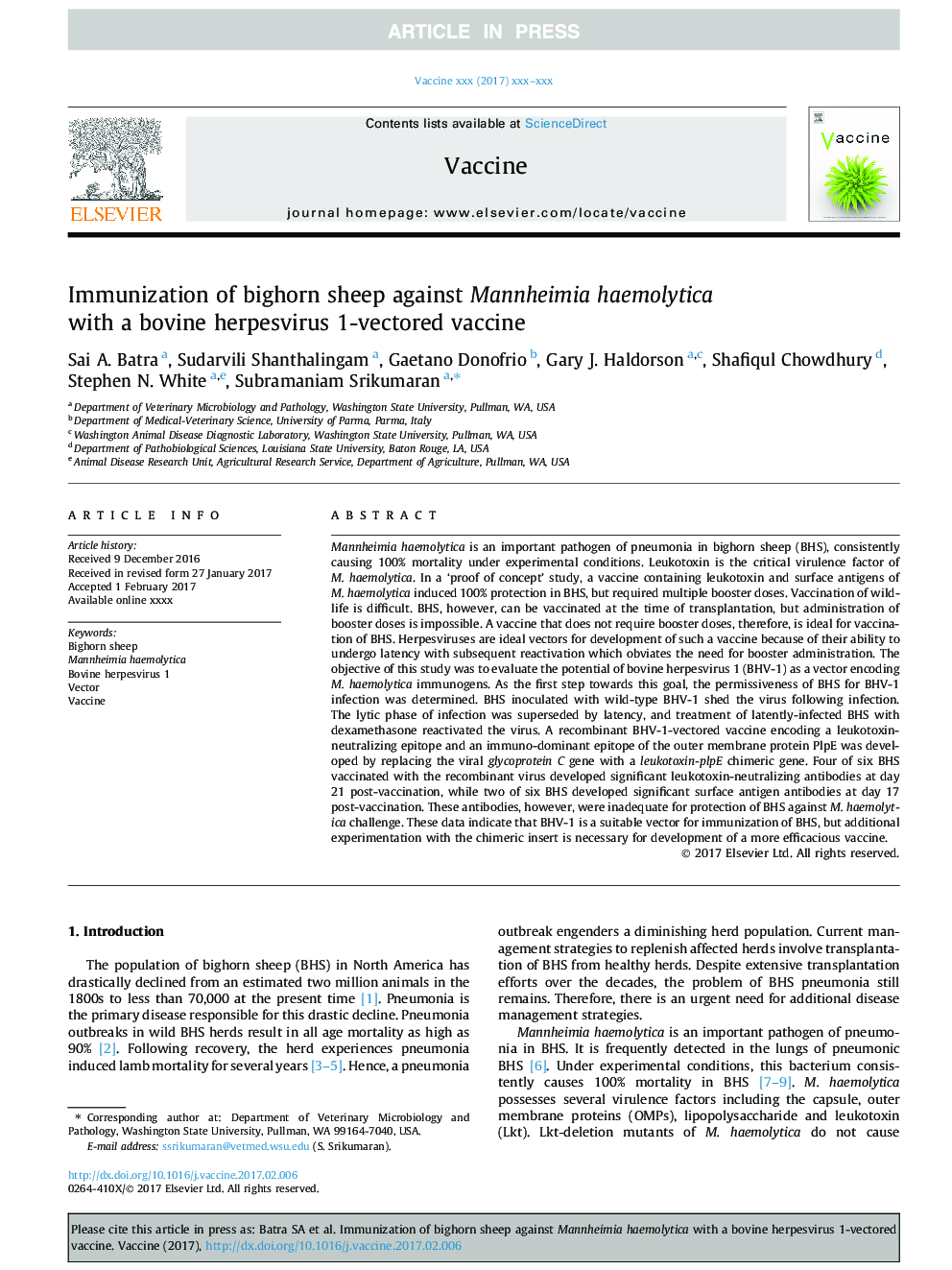| کد مقاله | کد نشریه | سال انتشار | مقاله انگلیسی | نسخه تمام متن |
|---|---|---|---|---|
| 5536563 | 1402295 | 2017 | 7 صفحه PDF | دانلود رایگان |
عنوان انگلیسی مقاله ISI
Immunization of bighorn sheep against Mannheimia haemolytica with a bovine herpesvirus 1-vectored vaccine
دانلود مقاله + سفارش ترجمه
دانلود مقاله ISI انگلیسی
رایگان برای ایرانیان
کلمات کلیدی
موضوعات مرتبط
علوم زیستی و بیوفناوری
ایمنی شناسی و میکروب شناسی
ایمونولوژی
پیش نمایش صفحه اول مقاله

چکیده انگلیسی
Mannheimia haemolytica is an important pathogen of pneumonia in bighorn sheep (BHS), consistently causing 100% mortality under experimental conditions. Leukotoxin is the critical virulence factor of M. haemolytica. In a 'proof of concept' study, a vaccine containing leukotoxin and surface antigens of M. haemolytica induced 100% protection in BHS, but required multiple booster doses. Vaccination of wildlife is difficult. BHS, however, can be vaccinated at the time of transplantation, but administration of booster doses is impossible. A vaccine that does not require booster doses, therefore, is ideal for vaccination of BHS. Herpesviruses are ideal vectors for development of such a vaccine because of their ability to undergo latency with subsequent reactivation which obviates the need for booster administration. The objective of this study was to evaluate the potential of bovine herpesvirus 1 (BHV-1) as a vector encoding M. haemolytica immunogens. As the first step towards this goal, the permissiveness of BHS for BHV-1 infection was determined. BHS inoculated with wild-type BHV-1 shed the virus following infection. The lytic phase of infection was superseded by latency, and treatment of latently-infected BHS with dexamethasone reactivated the virus. A recombinant BHV-1-vectored vaccine encoding a leukotoxin-neutralizing epitope and an immuno-dominant epitope of the outer membrane protein PlpE was developed by replacing the viral glycoprotein C gene with a leukotoxin-plpE chimeric gene. Four of six BHS vaccinated with the recombinant virus developed significant leukotoxin-neutralizing antibodies at day 21 post-vaccination, while two of six BHS developed significant surface antigen antibodies at day 17 post-vaccination. These antibodies, however, were inadequate for protection of BHS against M. haemolytica challenge. These data indicate that BHV-1 is a suitable vector for immunization of BHS, but additional experimentation with the chimeric insert is necessary for development of a more efficacious vaccine.
ناشر
Database: Elsevier - ScienceDirect (ساینس دایرکت)
Journal: Vaccine - Volume 35, Issue 12, 14 March 2017, Pages 1630-1636
Journal: Vaccine - Volume 35, Issue 12, 14 March 2017, Pages 1630-1636
نویسندگان
Sai A. Batra, Sudarvili Shanthalingam, Gaetano Donofrio, Gary J. Haldorson, Shafiqul Chowdhury, Stephen N. White, Subramaniam Srikumaran,